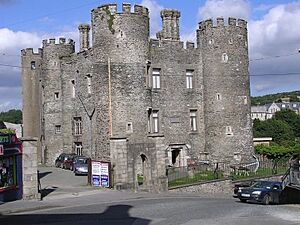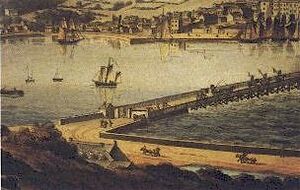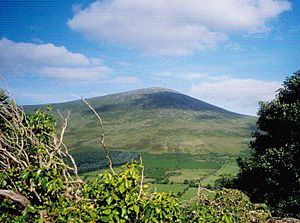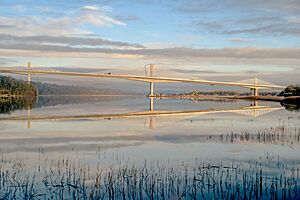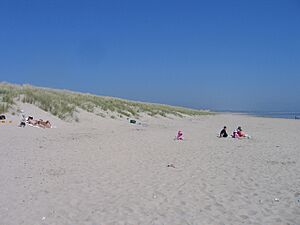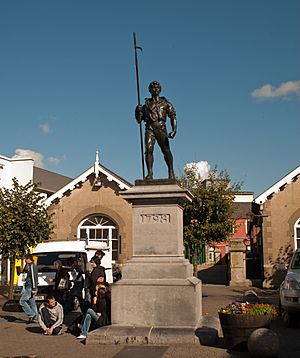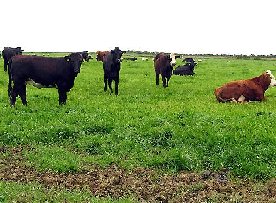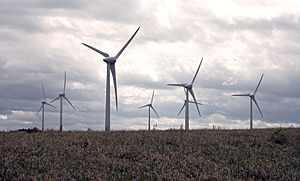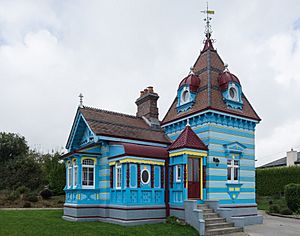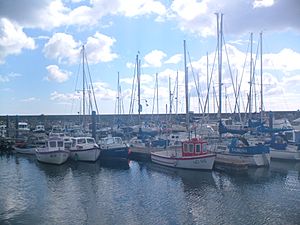County Wexford facts for kids
Quick facts for kids
County Wexford
Contae Loch Garman
|
||
|---|---|---|
|
||
| Nickname(s):
The Model County
|
||
| Motto(s): | ||
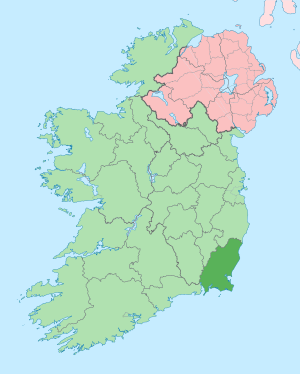
Location in Ireland
|
||
| Country | Ireland | |
| Province | Leinster | |
| Region | Southern | |
| Established | 1210 | |
| County town | Wexford | |
| Area | ||
| • Total | 2,367 km2 (914 sq mi) | |
| Area rank | 13th | |
| Highest elevation | 794 m (2,605 ft) | |
| Population
(2022)
|
||
| • Total | 163,527 | |
| • Rank | 14th | |
| • Density | 69.086/km2 (178.93/sq mi) | |
| Time zone | UTC±0 (WET) | |
| • Summer (DST) | UTC+1 (IST) | |
| Eircode routing keys |
Y21, Y25, Y34, Y35 (primarily)
|
|
| Telephone area codes | 051, 052, 053, 056 (primarily) | |
| Vehicle index mark code |
WX | |
County Wexford (Irish: Contae Loch Garman) is a county in Ireland. It is located in the Leinster province and is part of the Southern Region. The county is named after the town of Wexford. It was once the historic Gaelic area of Hy Kinsella (Uí Ceinnsealaigh), with Ferns as its main town. Wexford County Council is the local government for the county. In 2022, about 163,527 people lived here.
Contents
History of County Wexford
County Wexford has many signs of early human life. Ancient tombs called dolmens from the Stone Age can be found at Ballybrittas and Newbawn. There are also many remains from the Bronze Age. Early Irish tribes formed the Kingdom of Uí Cheinnsealaig, which was a bit larger than today's County Wexford.
Christianity and Viking Invasions
Wexford was one of the first parts of Ireland to become Christian in the early 400s. Later, starting in 819, Vikings attacked and looted many Christian sites. Vikings settled in Wexford town by the late 800s.
Norman Arrival and English Rule
In 1169, the Normans invaded Ireland through Wexford. This happened because Dermot MacMurrough, the King of Leinster, asked for their help. After this, the Cambro-Normans began to settle in the country.
During the 1300s, the native Irish started to take back some of their lands, especially in the north of the county. This was led by Art MacMurrough Kavanagh. Under King Henry VIII, many religious houses like Glascarrig Priory and Tintern Abbey were closed between 1536 and 1541.
Rebellions and Important Visits
A big rebellion started in Ireland on October 23, 1641, and County Wexford strongly supported it. In 1649, Oliver Cromwell and his English Parliamentarian Army took control of the county. The lands of the Irish and Anglo-Normans were taken and given to Cromwell's soldiers.
County Wexford was a very important place during the Irish Rebellion of 1798. Major battles happened at The Battle of Oulart Hill, Vinegar Hill (near Enniscorthy), and New Ross. The famous song "Boolavogue" was written to remember the Wexford Rising.
In 1916, a small rebellion happened in Enniscorthy town, at the same time as the Easter Rising in Dublin. In 1963, John F. Kennedy, who was the President of the United States, visited the county and his family's old home in Dunganstown, near New Ross.
Geography and Landscape
County Wexford is the 13th largest of Ireland's 32 traditional counties by size. It is the largest county in the province of Leinster. The county is in the southeast corner of Ireland. It has the Atlantic Ocean to the south and the Irish Sea to the east. The River Barrow forms its western border. The Blackstairs Mountains and the southern parts of the Wicklow Mountains are to the north. Wexford borders County Waterford, County Kilkenny, County Carlow, and County Wicklow.
Towns and Villages in Wexford
| Historical population | ||
|---|---|---|
| Year | Pop. | ±% |
| 1500 | 4,550 | — |
| 1510 | 4,344 | −4.5% |
| 1550 | 5,010 | +15.3% |
| 1580 | 6,224 | +24.2% |
| 1585 | 9,870 | +58.6% |
| 1600 | 12,343 | +25.1% |
| 1610 | 3,456 | −72.0% |
| 1653 | 13,004 | +276.3% |
| 1659 | 11,680 | −10.2% |
| 1668 | 13,351 | +14.3% |
| 1672 | 15,339 | +14.9% |
| 1680 | 29,875 | +94.8% |
| 1690 | 36,310 | +21.5% |
| 1700 | 48,660 | +34.0% |
| 1705 | 52,399 | +7.7% |
| 1710 | 68,980 | +31.6% |
| 1715 | 71,445 | +3.6% |
| 1720 | 79,880 | +11.8% |
| 1725 | 83,455 | +4.5% |
| 1735 | 88,611 | +6.2% |
| 1745 | 87,222 | −1.6% |
| 1755 | 84,114 | −3.6% |
| 1765 | 81,396 | −3.2% |
| 1771 | 84,233 | +3.5% |
| 1775 | 87,222 | +3.5% |
| 1781 | 90,566 | +3.8% |
| 1788 | 104,760 | +15.7% |
| 1790 | 125,881 | +20.2% |
| 1801 | 120,688 | −4.1% |
| 1811 | 131,970 | +9.3% |
| 1813 | 128,455 | −2.7% |
| 1816 | 141,389 | +10.1% |
| 1821 | 155,377 | +9.9% |
| 1821 | 170,806 | +9.9% |
| 1831 | 182,713 | +7.0% |
| 1841 | 202,033 | +10.6% |
| 1851 | 180,158 | −10.8% |
| 1861 | 143,954 | −20.1% |
| 1871 | 132,666 | −7.8% |
| 1881 | 123,854 | −6.6% |
| 1891 | 111,778 | −9.8% |
| 1901 | 104,104 | −6.9% |
| 1911 | 102,273 | −1.8% |
| 1926 | 95,848 | −6.3% |
| 1936 | 94,245 | −1.7% |
| 1946 | 91,855 | −2.5% |
| 1951 | 90,032 | −2.0% |
| 1956 | 87,259 | −3.1% |
| 1961 | 83,308 | −4.5% |
| 1966 | 83,437 | +0.2% |
| 1971 | 86,351 | +3.5% |
| 1979 | 96,421 | +11.7% |
| 1981 | 99,081 | +2.8% |
| 1986 | 102,552 | +3.5% |
| 1991 | 102,069 | −0.5% |
| 1996 | 104,371 | +2.3% |
| 2002 | 116,596 | +11.7% |
| 2006 | 131,749 | +13.0% |
| 2011 | 145,320 | +10.3% |
| 2016 | 149,722 | +3.0% |
| 2022 | 163,527 | +9.2% |
The county town is Wexford. The main market town is Gorey. Here are some of the towns and villages in County Wexford:
- Adamstown
- Arthurstown
- Ballycanew
- Ballycullane
- Ballyedmond
- Ballyfad
- Ballygarrett
- Ballyhack
- Ballymitty
- Ballywilliam
- Bannow
- Barntown
- Blackwater
- Bree
- Bridgetown
- Broadway
- Bunclody
- Camolin
- Campile
- Castlebridge
- Castletown
- Cleariestown
- Clohamon
- Clonroche
- Coolgreany
- Courtown
- Craanford
- Crossabeg
- Cullenstown
- Curracloe
- Duncannon
- Duncormick
- Enniscorthy
- Ferns
- Fethard-on-Sea
- Foulkesmill
- Gorey
- Hollyfort
- Inch
- Killinierin
- Kilmore
- Kilmore Quay
- Kilmuckridge
- Kiltealy
- Monamolin
- Monaseed
- Murrintown
- Monageer
- Monbeg
- Newbawn
- New Ross
- Oulart
- Oylegate
- Poulpeasty
- Rathangan
- Rosslare
- Rosslare Harbour
- Raheen
- Rathnure
- Saltmills
- Taghmon
- Watch House Village
- Wellingtonbridge
- Wexford
Mountains and Hills in Wexford
Wexford's landscape is mostly low, fertile land. The highest point is Mount Leinster at 795 meters (2,608 feet). It is part of the Blackstairs Mountains in the northwest, on the border with County Carlow.
Other high points include:
- Black Rock Mountain, 599 meters (1,965 feet)
- Croghan Mountain (or Croghan Kinsella), 606 meters (1,988 feet)
- Annagh Hill, 454 meters (1,490 feet)
- Slieveboy, 420 meters (1,378 feet)
Some notable hills are Carrigbyrne Hill, Camross Hill, Carrigmaistia, Bree Hill, Gibbet Hill, Vinegar Hill, Slievecoiltia, Forth Mountain, and Tara Hill.
Rivers, Lakes, and Islands
The two main rivers are the Slaney and the Barrow. The River Barrow is Ireland's second-longest river at 192 kilometers (119 miles). Smaller rivers include the Owenduff, Pollmounty, Corrock, Urrin, Boro, Owenavorragh, Sow, and Bann.
There are no large freshwater lakes in the county. However, there are small seaside lakes or lagoons called Lady's Island Lake and Tacumshin Lake.
The Saltee Islands are about 5 kilometers (3 miles) offshore from Kilmore Quay. The smaller Keeragh Islands are about 1.5 kilometers (1 mile) offshore from Bannow.
Wexford's Climate
County Wexford is often called Ireland's "sunny southeast" because it gets more sunshine than most of the country. This makes it a popular place to live. The county has a mild and changing oceanic climate without extreme temperatures. The North Atlantic Current helps keep winter temperatures moderate.
January and February are usually the coldest months, with temperatures from 4 to 9°C (39-48°F). July and August are the warmest, with temperatures from 13 to 19°C (55-66°F) near the coast and 12 to 22°C (54-72°F) inland. Winds usually blow from the southwest. Rain falls throughout the year, with an average of 800 to 1200 mm (31-47 inches) annually. Heavy snow is rare, but Mount Leinster often has snow in winter. Frost is common in winter, especially away from the coast.
Soil and Nature
Most of County Wexford was covered by an ice sheet during the last Ice age. When the ice melted, it left behind a mix of rocks, clay, sand, and gravel called glacial drift. This created rich soils that are good for farming.
The most common soil type is brown earths, which are well-drained and useful for many things. Gleys are the next most common, found mostly in the southeast and east of Gorey. These soils are poorly drained and often form bogland.
Common trees include oak, ash, sycamore, alder, blackthorn, hawthorn, beech, and birch. Gorse is also very common. Wexford has a special habitat called the grey dune, where many wild flowers grow, like the bee orchid. There are not many natural forests; most trees grow in hedgerows.
Wildlife in Wexford
Southeastern Wexford is an important place for wild birds. The North Slob (north of Wexford Harbour) is home to about 10,000 Greenland white-fronted geese each winter. This is about one-third of the world's population! In summer, Lady's Island Lake is a key breeding spot for terns, especially the roseate tern.
You can often see pheasants, woodpigeons, and feral pigeons throughout the county. Mute swans, mallards, kingfishers, and owls are also present. The red grouse, once common, is now very rare. The corncrake is also almost never seen anymore. Smaller birds like crows, swallows, and robins are very common.
Land mammals include badgers, rabbits, otters, hedgehogs, red foxes, mink, bats, squirrels, rats, and mice. There are two types of hares: the Irish hare and the less common brown hare. The stoat is also quite common.
Two types of seals live on Wexford's coast: Atlantic grey seals are very common, and the slightly smaller common (or harbour) seal is also plentiful. The small tortoiseshell butterfly is the most common butterfly in the county. Various types of moths are also common. The common frog is plentiful.
People and Population
In 2022, County Wexford had a population of 163,919 people. About 61.4% lived in rural areas, and 38.6% lived in towns. Most people (83.8%) said they were Roman Catholic. Between 2006 and 2011, the population grew by 10%, and by 3% between 2011 and 2016.
Main Towns and Their Populations
| Town | Population (2022) |
|---|---|
| Wexford | 21,524 |
| Enniscorthy | 12,310 |
| Gorey | 11,517 |
| New Ross | 8,610 |
Culture and Arts
Since 1951, the Wexford Festival Opera takes place every year in Wexford town. In 2008, a new building called the National Opera House replaced the old one. It has two theaters, the O'Reilly Theatre and the Jerome Hynes Theatre.
County Wexford is known for its singing traditions. Many traditional songs are about the Irish Rebellion of 1798. Singers like Paddy Berry, Seamus Brogan, and Niall Wall are well-known. Paddy Berry has also collected and published many Wexford songs.
The opening scenes of the movie Saving Private Ryan, showing the D-day assault, were filmed on beaches in Curracloe, County Wexford. Part of The Count of Monte Cristo was filmed in Duncannon in 2000. The movie Brooklyn (film) was partly set and filmed in Enniscorthy, with some locals as extras.
Media and News
Two radio stations are based in the county: South East Radio and Beat 102-103.
The main newspapers for the county include Wexford People, New Ross Standard, Gorey Guardian, and Enniscorthy Echo.
Places to Visit
The scenic Bannow Drive is a popular route for tourists. It goes through four Wexford villages: Duncormick, Cullenstown, Bannow, and Wellingtonbridge.
Ballyteigue Burrow, near Duncormick, has one of Ireland's best protected sand dune systems. It is full of wildflowers, wildlife, and butterflies. This 9 km (6 mile) coastal area is a protected nature reserve.
The Hook Peninsula is famous for its many beaches and beautiful views. It has the old Hook Head lighthouse and the historic Loftus Hall.
Popular beaches are found at Courtown, Curracloe, Carnsore Point, Duncannon, and Rosslare Strand.
Other interesting places to see:
- Ferns Castle and Abbey
- Enniscorthy Castle and Museum
- Vinegar Hill
- National 1798 Visitor Centre
- Boolavogue
- The Browne-Clayton Monument
- Oulart Hill
- Castleboro House
- The Seven 'Castles' of Clonmines
- Johnstown Castle
- Dollar Bay
- Loftus Hall – an old, supposedly haunted house (the first building was here in 1350)
- Ballyteigue Castle
- Bannow Church (from the 1200s)
- Selskar Abbey, Wexford town
- Irish National Heritage Park (Ferrycarrig)
- Tacumshin windmill (southeast County Wexford)
- St. Mary's Church, New Ross
- Dunbrody Abbey
- Tintern Abbey
- Slade Castle
- Ballyhack Castle
- J.F. Kennedy homestead and park
- Slieve Coilte
- Wells House and Gardens
- Duncannon Fort
- Saltee Islands
Economy and Industry
Farming in Wexford
The economy of County Wexford is mainly based on farming. Farmers raise cattle, sheep, pigs, and some horses. Growing wheat, barley, rapeseed, and oats is also common, as are potatoes.
Wexford strawberries are very famous and can be bought in shops and roadside stalls during summer. Every year in late June, a 'Strawberry Fair' Festival happens in Enniscorthy, where a Strawberry Queen is crowned. Dairy farming is also a big part of the farming industry. You can find local milk in many supermarkets. Wexford Irish Cheddar is a well-known cheese brand, and Carrigbyrne, a soft cheese, is made near New Ross.
Forestry and Trees
Many evergreen trees are grown, especially in recent years. Norway spruce and Sitka spruce are the most common types planted. These are usually grown on poorer soils, like in bogs or on hills. Some deciduous trees are also planted, but they need better soil.
Energy Production
Carnsore Point was in the news in the late 1970s because there was a plan to build a nuclear energy plant there. However, the plans were stopped after many public protests due to environmental and health worries.
The Great Island Power Station opened in 1967. It uses heavy fuel oil to make electricity. A wind farm with 14 wind turbines has now been built on the site. It was finished in 2002 and was the first wind farm on Ireland's east coast. Other wind farms now exist in the county, such as Ballywater Wind Farm near Kilmuckridge.
Transportation
- Bus: Bus Éireann route 2 connects Wexford and Dublin. Route 5 goes from Waterford to New Ross, Enniscorthy, and Dublin. There are also many local bus routes from Wexford town to places like Kilmore Quay and Kilmuckridge.
- Rail: The Rosslare–Dublin railway line runs through the county, stopping at Rosslare Europort, Rosslare Strand, Wexford, Enniscorthy, and Gorey. Four trains run each way daily.
- Ferry: Rosslare Europort, at Rosslare Harbour, has busy ferry services. There are regular trips to Wales (Pembroke and Fishguard) and France (Cherbourg and Roscoff in summer) for people and vehicles. There is also a ferry between Ballyhack and Passage East (County Waterford), crossing the Barrow estuary.
Sports and Events
Gaelic Games
Wexford is well-known for hurling. The county has won the Leinster Senior Hurling Championship 21 times, first in 1890 and most recently in 2019. In the All Ireland Senior Hurling Championships, Wexford has won 6 times, with the last win in 1996.
Camogie, a women's version of hurling, is also played. Wexford won the All Ireland in camogie in 2007, 2010, 2011, and 2012. Wexford Park is the county's main GAA pitch, holding 25,000 fans.
Football
Wexford Youths F.C., formed in 2007 and renamed Wexford FC in 2017, is the main football club in the county. They play in the League of Ireland First Division.
Golf
There are many golf clubs in the county, including Rosslare (a Links course) and Enniscorthy. Two more are near Gorey: Ballymoney Golf Club and Courtown Golf Club. Bunclody Golf and Fishing Club has Europe's only golf lift.
Fishing
Fishing happens in many places in County Wexford, like Kilmore Quay and Slade Harbour. Common fish include herring, mackerel, cod, monkfish, whiting, bass, perch, gurnard, haddock, mullet, pollock, John Dory, sole, conger eel, shad, salmon, trout, pike, carp, and tench. Shellfish like mussels, cockles, periwinkles, clams, and oysters are also found.
Racing
Wexford Racecourse (for horse racing) is in Wexford town. There is also a Greyhound Racing track in Enniscorthy.
Famous People from Wexford
- John Banville – a famous novelist
- John Barry – Commander in the United States Navy
- Paddy Berry – a singer and collector of songs
- Wallis Bird – a musician
- Eoin Colfer – a best-selling writer of children's literature
- Brendan Corish – a former leader of the Irish Labour Party
- Gordon D'Arcy – a rugby player for Leinster and Ireland
- Tadhg Furlong – a rugby player for Leinster and Ireland
- Eileen Gray – a famous 20th-century furniture designer and architect
- John F. Kennedy – former president of the United States (his great-grandparents were from Wexford)
- Father John Murphy – a leader in the 1798 Rebellion
- Nicky Rackard – a famous hurling player
- John Redmond – an important politician in the 1800s and 1900s
- Billy Roche – a playwright
- Martin Storey – a hurling player
- Colm Tóibín – a novelist
See also
 In Spanish: Condado de Wexford para niños
In Spanish: Condado de Wexford para niños



